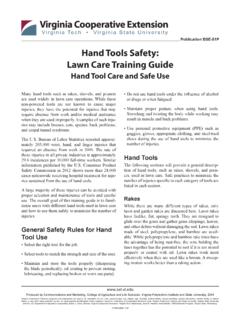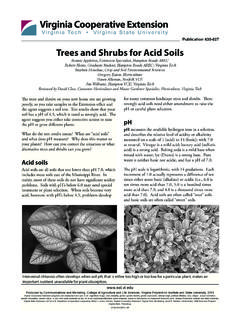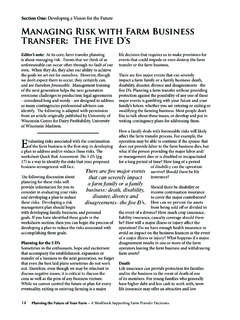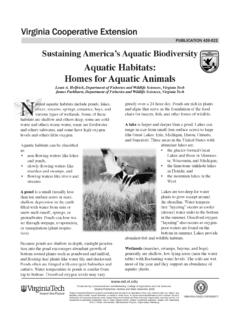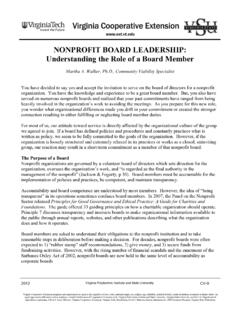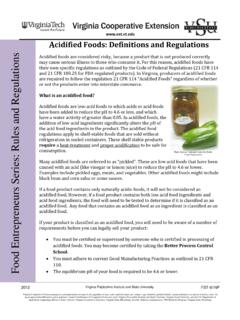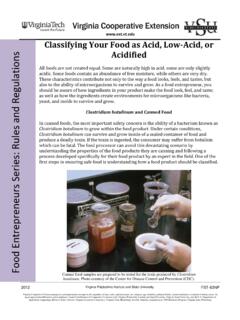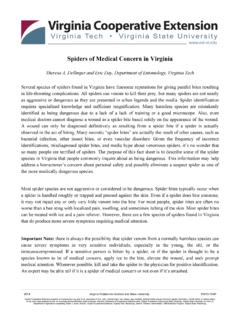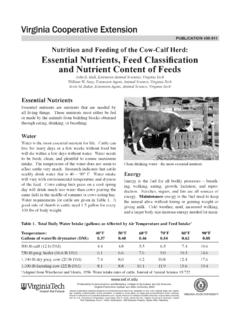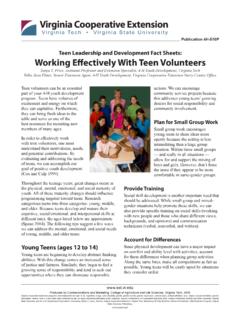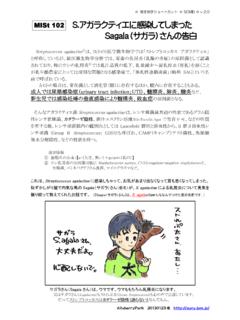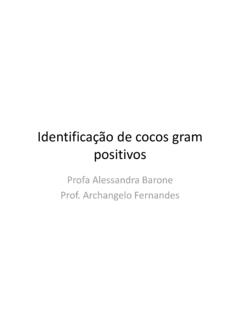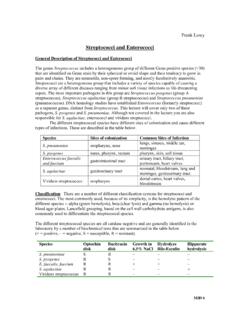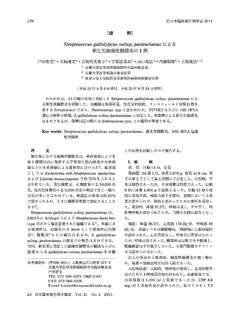Transcription of Streptococcus uberis: A Practical Summary for Controlling ...
1 PUBLICATION DASC-8P. Streptococcus uberis: A Practical Summary for Controlling Mastitis Christina S. Petersson-Wolfe, Assistant Professor, Dairy Science, Virginia Tech John Currin, Clinical Instructor, Virginia-Maryland Regional College of Veterinary Medicine The implementation of control measures for contagious How Can You Prevent and Control mastitis pathogens has successfully reduced the preva- lence of these organisms in dairy herds. However, Mastitis Caused by S. uberis? Controlling environmental pathogens remains a daunt- The control of S. uberis includes maintenance of a ing task. Streptococcus uberis is Gram-positive, with clean and dry housing environment and implementa- a cell wall structure similar to Staphylococcus spp.
2 , as tion of proper milking procedures. At milking time, well as streptococci such as S. agalactiae and S. dys- all quarters should be forestripped, which will begin galactiae. S. uberis is the most common Streptococcus the milk let-down process. Following forestripping, the species isolated from cases of mastitis. use of an FDA-approved and efficacious pre-milking teat disinfectant is particularly important for this mas- titis-causing pathogen. The pre-milking teat disinfec- Where Are These Organisms tant should remain on the teats for 30 seconds prior to removal with either a paper towel or a single-use clean Found?
3 And dry cloth towel. Following these guidelines, the These are environmental organisms commonly found time from the start of manual stimulation (forestrip or in manure and other organic matter, including bed- wipe) to unit attachment should be in the range of 60. ding. Poor udder cleanliness, inadequate stall manage- to120 seconds. This will allow the appropriate time for ment, and damaged teat ends also appear to increase milk let down. the risk of spreading S. uberis to uninfected cows. Following unit detachment, the application of an FDA- How Does S. uberis Spread to the Mam- approved and efficacious post-milking teat disinfectant mary Gland?
4 Should be applied with coverage over at least two- thirds of the teat barrel. In herds with a particular envi- S. uberis will spread to uninfected cows through envi- ronmental mastitis problem, the use of a barrier teat ronmental contact. Reducing environmental contact dip is recommended. with S. uberis is especially important in the early dry period. As with all environmental organisms, maintain- In addition, reducing teat end exposure between milk- ing a clean and dry environment for cows to lie in is ings by scraping the back of cow stalls (where the of utmost importance. In particular, the use of inorganic udder rests) and applying fresh bedding frequently is bedding (sand) will reduce the environmental contami- imperative.
5 The application of bedding condition- nation with these bacteria. However, it is important to ers such as hydrated lime is effective at reducing the remember that recycled sand can still serve as a source bacterial load in the bedding. However, the activity of of environmental contamination because the organic these products is short-lived. Thus, frequent applica- matter builds on the bedding material. tion is required. It is recommended that 2 pounds be applied per stall, and it must be applied every other day. Produced by Communications and Marketing, College of Agriculture and Life Sciences, Virginia Polytechnic Institute and State University, 2012.
6 Virginia Cooperative Extension programs and employment are open to all, regardless of race, color, national origin, sex, religion, age, disability, political beliefs, sexual orientation, or marital or family status. An equal opportunity/affirmative action employer. Issued in furtherance of Cooperative Extension work, Virginia Polytechnic Institute and State University, Virginia State University, and the Department of Agriculture cooperating. Edwin J. Jones, Director, Virginia Cooperative Extension, Virginia Tech, 1. Blacksburg; Jewel E. Hairston, Administrator, 1890 Extension Program, Virginia State, Petersburg.
7 VT/0712/DASC-8P. The use of blanket dry cow therapy with a long-lasting How Likely Are S. uberis Infections to antibiotic preparation is an effective way to cure exist- ing infections at drying off. Furthermore, studies report Cure? the use of an internal teat sealant will significantly These infections are often difficult to cure with tradi- reduce the new intramammary infection (acquired dur- tional intramammary antibiotic preparations. Some ing the dry period) caused by environmental strepto- veterinarians have had greater success with systemic cocci, which includes S. uberis. The use of an internal administration of penicillin.
8 However, veterinary teat sealant in conjunction with blanket dry cow ther- consultation is recommended prior to the start of any apy will double the cost of dry cow treatment. How- treatment protocol. Due to the nature of these bacteria, ever, in herds where environmental streptococci are the emphasis needs to be placed on prevention of these predominant bacteria isolated from clinical mastitis, infections, rather than focused on treatment. this is an effective way to prevent new infections and cure existing infections during the dry period. Quick Notes S. uberis is an environmental organism commonly When Are S.
9 Uberis Infections Most found in manure and bedding. Likely to Occur? New infections are most likely to occur during the New infections can occur at any time during lactation early dry period. and may also occur during the dry period. However, the risk for new infection with S. uberis has been reported It is imperative to keep bedding clean and dry. greatest during the early dry period. Following milk cessation, cows do not experience the daily flushing of The use of washed sand bedding that is properly the gland and are at an increased risk for mastitis in the dried will help reduce the environmental load of S.
10 Early dry period. Cows in early lactation are also at uberis. increased risk for new infections due to the increased stress and immune suppression associated with the Proper milking procedures, including predip and postpartum period. Cows with high milk production are postdip applications, are extremely important in the not at greater risk than cows with low milk production. prevention of these infections. 2.
